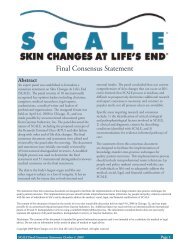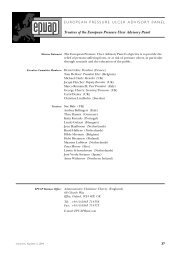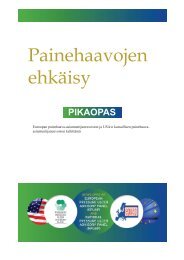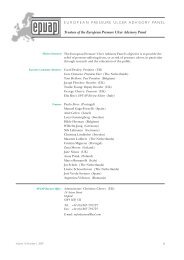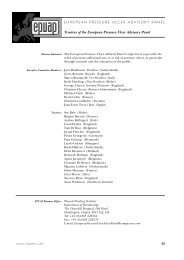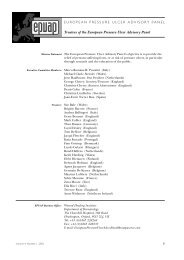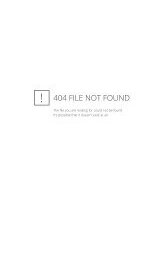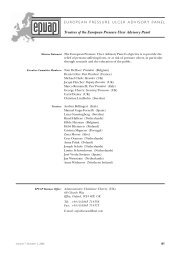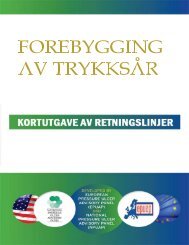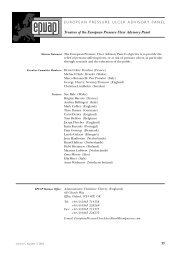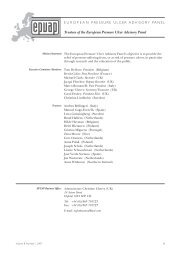EPUAP Review 5/2 RIP - European Pressure Ulcer Advisory Panel
EPUAP Review 5/2 RIP - European Pressure Ulcer Advisory Panel
EPUAP Review 5/2 RIP - European Pressure Ulcer Advisory Panel
You also want an ePaper? Increase the reach of your titles
YUMPU automatically turns print PDFs into web optimized ePapers that Google loves.
EUROPEAN PRESSURE ULCER ADVISORY PANEL<br />
While the amount of supplementation required by individuals<br />
will vary, general guidance can be offered where<br />
an individual may require a minimum of 30–35 kcal per kg<br />
body weight per day, with 1 to 1.5 g/kg/day protein required<br />
and 1ml per kcal per day of fluid intake.<br />
Specific guidance on energy expenditure may be provided<br />
through the use of standard equations such as the<br />
Harris-Benedict or Schofield formulae although it is recommended<br />
that advice on their use and interpretation be<br />
sought from a dietician (where available) or the multidisciplinary<br />
care team.<br />
The success of nutritional intervention should be reviewed<br />
within the on-going regular nutritional assessments<br />
and may be indicated by outcomes such as increased weight<br />
or improved functional ability and/or enhanced healthrelated<br />
quality of life. Successful nutritional intervention<br />
may also be marked by a reduced incidence of new pressure<br />
ulcers and the healing of established pressure ulcers.<br />
Regular evaluation of the effects of nutritional interventions<br />
is required but it should be borne in mind that where<br />
individuals are malnourished the effects of feeding and/or<br />
supplementation may not be immediately apparent, probably<br />
because there first needs to be a restoration of already<br />
depleted reserves.<br />
Where patients have established pressure ulcers then a<br />
similar strategy of nutritional intervention should normally<br />
be considered (normal feeding, then oral supplements and<br />
finally tube-feeding) although the demands may be greater.<br />
There are a number of observations upon the role of nutritional<br />
deficiencies and pressure ulcer healing that can be<br />
extracted from controlled trials – protein and calorie supplementation,<br />
along with the use of arginine, vitamins and<br />
trace elements with antioxidant effects appear to have a<br />
positive effect on healing (Recommendation 1, B; Benati<br />
et al., 2001, Bourdel-Marchasson et al., 2000, Breslow et al.,<br />
1993, Chernoff et al., 1990, Delmi et al., 1990). The evidence<br />
for the value of ascorbic acid supplementation is equivocal<br />
(Recommendation 1, B; Taylor et al., 1974, ter Riet et al.,<br />
1995), and the evidence for zinc supplementation is weak<br />
(Recommendation 1, B; Norris 1971).<br />
Specific issues may need to be resolved if normal feeding<br />
is to be enhanced – for example control of wound odour,<br />
altered body image, pain associated with the pressure ulcer<br />
and loss of self-esteem because these issues can reduce nutritional<br />
intake.<br />
Where individual patients present with severe pressure<br />
ulcers (Grades 3 and 4) then the multidisciplinary team<br />
should consider their basal energy expenditure and pay<br />
particular attention to the increased fluid loss through such<br />
wounds.<br />
The nutritional requirements of specific groups may be<br />
different from those outlined in these guidelines, for example<br />
the spinal cord injured.<br />
Nutritional assessment and intervention should of<br />
course be combined with all other appropriate interventions<br />
including pressure management.<br />
These guidelines have not addressed several specific issues<br />
– nutritional assessment and intervention in neonates<br />
and paediatrics, the role of parenteral nutrition and specific<br />
needs of individual patient groups such as the immunosuppressed,<br />
those with cancers, orthopaedic, trauma and<br />
surgical patients and those who have experienced burns.<br />
52<br />
Pharmacological interventions such as the use of anabolic<br />
steroids also are not included.<br />
In all of the preceding recommendations regarding nutritional<br />
assessment and supplementation all decisions<br />
should be taken with regard to patient choice and in light<br />
of the overall goals of treatment.<br />
Education<br />
There is a requirement for all staff (including but not limited<br />
to health professionals, untrained staff, catering and<br />
porters) to be aware of the importance of nutrition and to<br />
understand their role in improving the nutritional status of<br />
patients. This education will range from the performance<br />
of nutritional screening and assessment, the preparation<br />
of attractive, appetizing meals and the delivery and presentation<br />
of meals dependent upon the needs of individual<br />
staff members. There is a need to establish a nutritional<br />
culture within healthcare prompting the appropriate availability<br />
and presentation of meals through to continuity of<br />
nutritional care across departments and care settings.<br />
Summary of Recommendations<br />
The <strong>EPUAP</strong> recommends that as a minimum, assessment<br />
of nutritional status should include regular weighing of<br />
patients, skin assessment, documentation of food and fluid<br />
intake. Additional procedures including anthropometric<br />
measurements and laboratory tests may also be performed<br />
although these may best be viewed as more advanced assessment<br />
techniques. Nutritional intervention should focus<br />
upon improving the individual’s intake of food and fluids –<br />
through consideration of the quality of what is offered along<br />
with removing physical or social barriers to its consumption.<br />
Nutritional supplementation may be considered where<br />
it is not possible to enhance the individual’s own consumption<br />
of food and fluids.<br />
References used in the Development of this Guideline<br />
American Society for Parenteral and Enteral Nutrition<br />
Board of Directors. Definition of terms used in<br />
ASPEN guidelines and standards. JPEN 1995; 19: 1–2.<br />
Benati G, Delvecchio S, Cilla D, & Pedone V. Impact on<br />
pressure ulcer healing of an arginine enriched<br />
nutritional solution in patients with severe cognitive<br />
impairment. Arch Gerontol Geriatr, 2001, 33 Suppl 1,<br />
43–47.<br />
Bourdel-Marchasson I, Barateau M, Rondeau V, Dequae-<br />
Merchadou L, Salles-Montaudon N, Emeriau JP,<br />
Manciet G, & Dartigues JF. A multicenter trial of the<br />
effects of oral nutritional supplementation in critically<br />
ill older inpatients. GAGE Group. Groupe Aquitain<br />
Geriatrique d’Evaluation. Nutrition, 2000, 16(1), 1–5.<br />
Breslow RA, Hallfrisch J, Guy DG, Crawley B, & Goldberg<br />
AP. The importance of dietary protein in healing<br />
pressure ulcers. J Am Geriatr Soc, 1993, 41(4), 357–362.<br />
Chernoff RS, Milton KY, & Lipschitz DA. The effect of a<br />
very high protein liquid formula on decubitus ulcers<br />
healing in longterm tubefed institutionalised patients.<br />
J Am Diet Assoc,1990, 90, A–130.<br />
Delmi M, Rapin CH, Bengoa JM, Delmas PD, Vasey H, &<br />
Bonjour JP. Dietary supplementation in elderly<br />
Volume 5, Number 2, 2003



